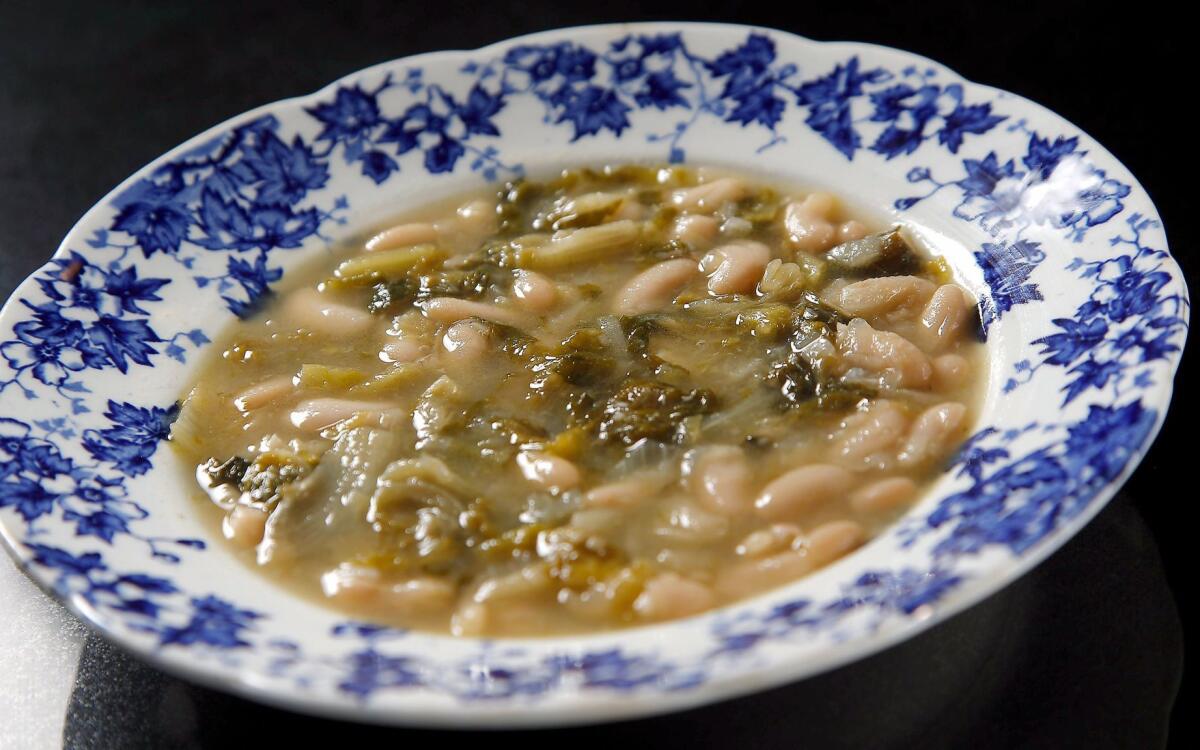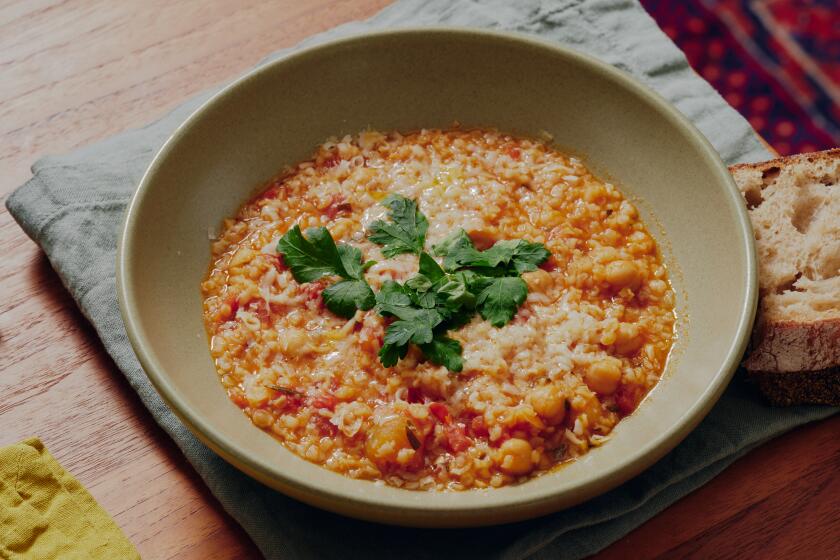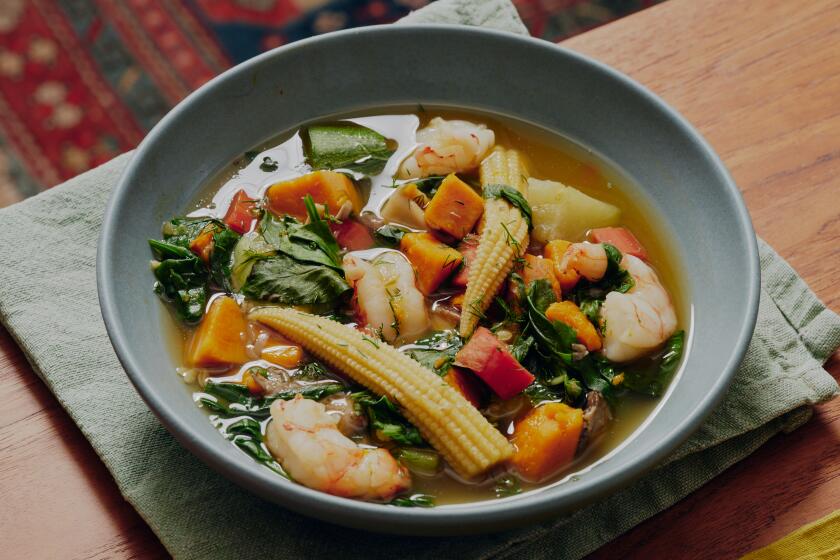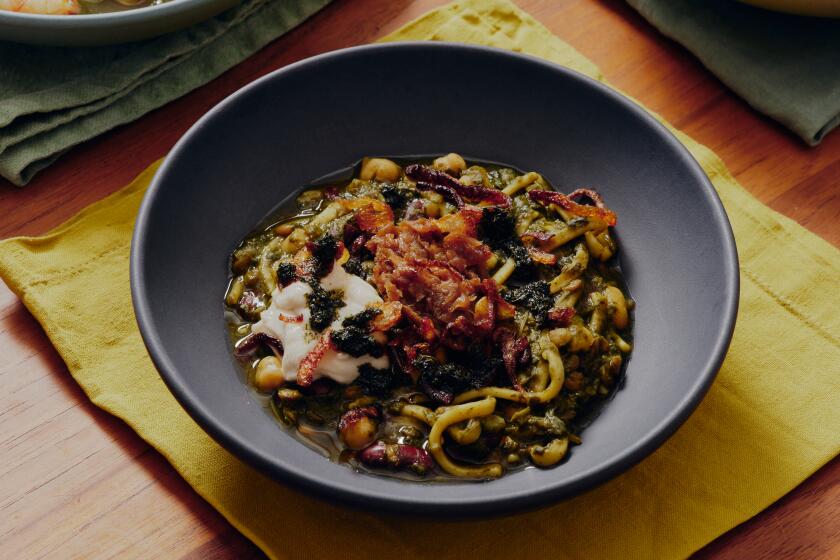White bean and escarole soup with olio nuovo

- Share via
Jews have long celebrated Hanukkah by deep-frying pastries — Iraqi zengoula, Indian jalabi, Spanish and Mexican buñuelos, Italian frittelle, Israeli sufganiyot — and pan-frying potato latkes. But it’s the oil — specifically olive oil — and not the cooking method that’s commemorated during the festival of lights.
And the moment olive oil aficionados wait for all year is the release of olio nuovo, the ultra-green first bottling of the year’s first pressing. Skimmed from the vat before the sediment has settled, olio nuovo has a creamy texture and heightened notes of fruit, grass and pepper. As with the Hanukkah oil, olio nuovo is a fleeting ritual, best savored within a few weeks of its release.
December is peak time for new oil, and a number of Los Angeles chefs and stores, from Eataly to Costco, are showcasing the freshly-milled oils from Italian and California producers, making olio nuovo a symbolically and seasonally perfect Hanukkah ingredient — and not a bad holiday gift. (Other oil-producing countries don’t export much of the new oil.)
Olio nuovo “is the first expression of the olive harvest,” says Albert Katz, producer of award-winning olive oil in eastern Napa County and a co-founder of the California Olive Oil Council.
“There is nothing like the first few days of pressing — that rustic, green, unfiltered oil; those first fresh, fruity, intense, viscous drops,” says Katz. Most of the pressing will be left to settle and mellow for several weeks, then “racked off” from perishable solids before bottling to become shelf stable. “After that,” Katz says, “it’s just good oil.”
The best oils are estate-grown, with fruity, bitter and pungent flavors. There are three styles — light, medium, robust — determined by olive varietals, where and how they were grown, when harvested and the miller’s preferences.
Appreciation for olio nuovo in the U.S. is due in large part to Rolando Beramendi, founder of Manicaretti, importer of Italian delicacies, who first introduced the Tenuta di Capezzana from Tuscany to influential California chefs Judy Rogers, Paul Bertolli and Nancy Silverton in the early 1990s.
You can find bottles of olio nuovo at Monsieur Marcel at the Original Farmers Market, L.A.’s recently opened Eataly, if you’re lucky at your local farmers market — even at Costco. (It’s often pricier than other olive oils; and imported are typically more expensive than domestic.)
Once you open your bottle, “use immediately; pour abundantly,” Beramendi writes in the cookbook “Autentico: Cooking Italian, the Authentic Way,” published in October. And keep dishes simple to showcase the oil; olio nuovo can elevate whatever you started with into something transcendent. (Think: spaghetti aglio e olio.)
Maybe the purest taste experience is on grilled bread, with just a sprinkle of good salt. Instead of chopped liver, begin your Hanukkah festivities with crusty bread and olio nuovo.
If you want something a little more involved than bread and oil, boiled potatoes dressed up with parsley, vinegar, pepper and olio nuovo can become a substitute for latkes. The oil makes a terrific finish to a pot of bean and escarole soup. And then there is olive oil cake, made with semolina and oranges and finished with pistachios and chocolate — and more olio nuovo.
So this year, don’t fry all the Hanukkah oil. The method may have changed — neither people nor animals power the mill — but winter’s oil production is essentially the same as in ancient times: crush, press, separate. Now, that’s something to celebrate.
Two upcoming Los Angeles olio nuovo events:
Nancy Silverton is celebrating the launch of Rolando Beramendi’s “Autentico: Cooking Italian, the Authentic Way” (St. Martin’s Press, 2017), with a lunch featuring olio nuovo at noon Dec.10 at Chi Spacca. 6610 Melrose Ave, Los Angeles,(323) 297- 1133, chispacca.com.
Akasha Richmond of AR Cucina is featuring Sicilian olio nuovos throughout the season, including Hanukkah specials and a Christmas Eve Feast of Seven Fishes. 9531 Culver Blvd., Culver City, (310) 558-8800, arcucina.com.
Italy
Tenuta di Capezzana. Region: Carmignano, Tuscany. Olive cultivars: Moraiolo, Frantoio, Pendolino, Leccino. Grassy, “spring in a bottle,” elegantly robust, marries instantly and harmoniously with food. About $50-$55 for 500 ml. Monsieur Marcel, Cheese Store of Beverly Hills, Bay Cities Italian Deli, www.markethallfoods.com
Marchesi de’ Frescobaldi Laudemio. Region: Florence, Tuscany. Olive cultivars: Frantoio, Moraiolo, Leccino. Brilliant green; floral, wheat and artichoke aromas; “grand Tuscan” robust bitterness and pepper. $50-$55 for 500 ml. Monsieur Marcel, www.markethallfoods.com.
Gianfranco Becchina Olio Verde Novello. Region: Belice, (western) Sicily. Olive cultivar: Nocellara del Belice. Intensely green; herbaceous; medium bitterness, spice and pepper; hint of nuts. $45-$50 for 500 ml. www.markethallfoods.com.
Titone. Region: Trapani, Sicily. Olive cultivars: Nocellara del Belice, Cerasuola, Biancolilla. Rich, nutty, herbaceous, fruity, medium pepper. $35-$40 for 250 ml. Mozza2Go, Monsieur Marcel, www.markethallfoods.com.
California
Bondolio. Region: Winters, Yolo County. Olive cultivars: Nocellara, Biancolilla, Cerasuola. Softer Sicilian style, nutty, hints of sweetness, fruit forward, floral, gentle pepper, medium blend. $32-$35 for 500 ml. We Olive stores under the We Olive label, www.bondolio.com and www.markethallfoods.com.
Katz Organic December’s New Oil. Region: Suisun Valley, Napa County. Olive cultivars: Leccino, Frantoio, Maurino. Tuscan-style, medium-bold, golden green, brash and daring, spice, herbs, pepper, artichoke, hint of nut. $25 for 375 ml. Monsieur Marcel, www.katzfarm.com, www.markethallfoods.com.
Seka Hills Estate Olio Nuovo. Region: Yocha Dehe Wintun Nation, Brooks, Capay Valley. Olive cultivar: Arbequina. Very approachable, fresh, bright, grassy, delicate pepper. $16-$20 for 250 ml. Monsieur Marcel, www.sekahills.com, www.markethallfoods.com.
California Olive Ranch Limited Reserve and Olio Nuovo. Region: primarily Yolo and Butte Counties. Limited Reserve: Olive varietals: Koroneiki, Arbequina. Producer describes notes of pear, tropical fruits, and green grass. $19.99 for 500 ml. exclusively online at californiaoliveranch.com. Olio Nuovo: Olive cultivar: Arbequina. Medium intensity, hints of green banana. $10.99 for 1 liter. Los Angeles and other select Costco regions.
Amelia Saltsman is the author of “The Seasonal Jewish Kitchen” and “The Santa Monica Farmers’ Market Cookbook.”
In a large pot, peel and halve one of the onions and combine with the beans, celery, carrot, garlic and sage or rosemary. Add water to cover by 2 inches and stir in 2 to 3 tablespoons olive oil. Loosely cover and bring to a boil over medium-high heat. Reduce the heat to a simmer and cook, partially covered, until the beans are very tender, about 1 hour, adding water to pot if needed to keep beans submerged. (If using unsoaked beans, they will absorb more water and cooking can take up to 2 hours.)
Remove and discard the onion, celery, carrot and sage. Fish out the garlic cloves and place in a small bowl, smashing them with the back of a spoon to form a paste. Stir the garlic paste back into the pot and season the beans with 1 teaspoon salt, or to taste. (The beans can be made a day or 2 in advance and refrigerated.)
Core and wash the escarole, shaking off any excess water, and roughly chop into large, bite-sized pieces. Finely chop remaining onion. In a large skillet, heat a couple tablespoons of olive oil over medium heat. Add the onion and a little salt to the pan, along with the chile broken in half. Cook, stirring frequently, until onions are softened and pale golden, 7 to 10 minutes. Add the escarole and a little more salt to the pan, stirring occasionally, until the escarole wilts, becomes tender and color darkens, 10 to 15 minutes. Add a little water, as needed, if the mixture begins to stick to the pan.
Add the cooked escarole to the beans, adding additional water or broth as needed so the mixture has a thick, soup-like consistency. Place the pot over medium heat to warm and marry the flavors, 10 to 15 minutes. Season with 1 teaspoon salt and ¼ teaspoon pepper, or to taste.
Place a slice of grilled or toasted bread in each soup bowl. Ladle over the soup and top each serving with a drizzle of olio nuovo.
Get our Cooking newsletter.
Your roundup of inspiring recipes and kitchen tricks.
You may occasionally receive promotional content from the Los Angeles Times.















